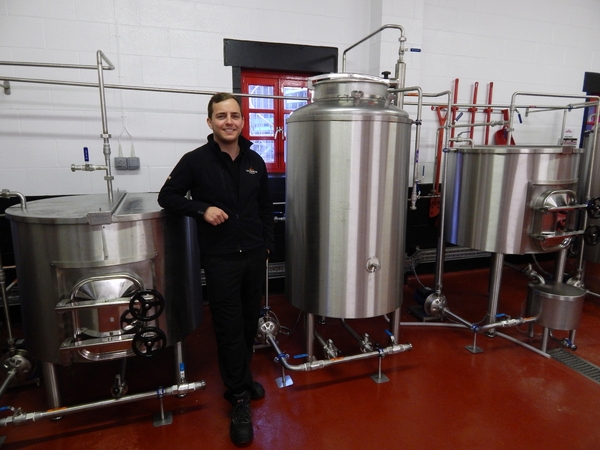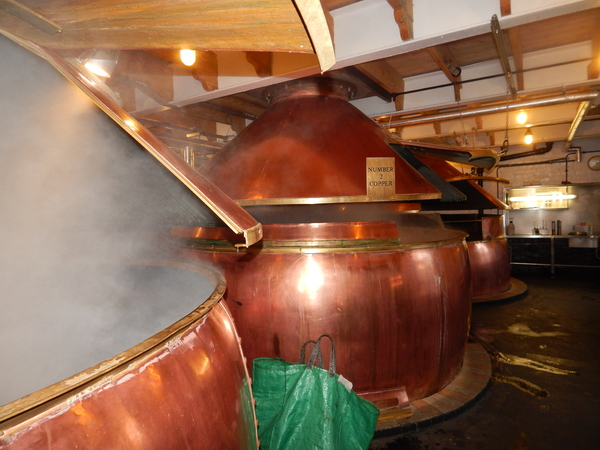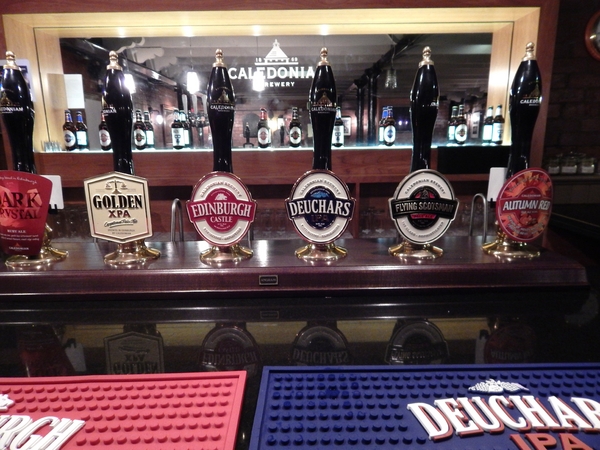Wee George boosts Caley's beer range
Added: Wednesday, December 2nd 2015

If you think Edinburgh’s Caledonian Brewery is a one-beer plant, famous for its award-winning Deuchars IPA, think again. On a wet and bitterly cold day, I warmed the proverbial cockles with an oatmeal stout called Double Dark and then sampled an American-style IPA, a cross-border Anglo-Scottish bitter and a traditional Scottish 80 Shilling before heading off to inspect “Caley’s” new micro-plant called Wee George.
To say the brewery has had a chequered history is to down-play its tumultuous past. It was founded in 1869 as Lorimer & Clark and became a member of the Vaux Group based in Sunderland. It seemed destined to disappear when Vaux off-loaded it but it was saved by Russell Sharp, whose background was whisky with Chivas Regal, but he quickly learned the brewing and marketing skills in the tough Scottish beer industry.
When Sharp retired, Caley was bought by mighty Scottish & Newcastle, which morphed into Heineken UK. Cynical thoughts that Heineken might have little interest in an ale brewery using Victorian kit have – if you’ll pardon the expression – been scotched. Caley is alive and thriving and managing director Andy Maddock and beer manager Craig Steven say the Dutch giant has encouraged them to expand the ale range.
And more than encourage. £180,000 has been invested in Wee George, a pilot brewery where new beers are tested. If they meet with consumer approval, then they move to the main plant and become either regular or seasonal beers.
It’s named in honour of one of the brewery’s founders, George Lorimer. It can produce a minimum of 20,000 pints and is run by Ross O’Hara (pictured above), a graduate of the brewing and distilling school at the local Heriot-Watt University.
Wee George is a modern piece of stainless steel kit, made in Scotland. But the production process is strictly traditional so beers can be replicated in the main plant. O’Hara even uses whole flower hops – placed in a muslin bag – to reproduce the exact flavours of the beer in the main plant.
To prove the point, the first beer made in Wee George earlier this year was a batch of Deuchars IPA. As IPA – a former Champion Beer of Britain – accounts for more than half Caley’s production, is one of the Top 10 alcohol brands in Scotland and is on sale as far south as Cornwall, proving that tastes and aromas can be matched from one batch to another is vital.
The first new beer that went through the innovation process was Coast to Coast, which saw Caley dipping its toes in the American pale ale sector. It met with instant approval from drinkers and is now a regular beer. It’s 4.6% and has a punchy 40 units of bitterness from the use of Simcoe American hops. The hops deliver the intense grapefruit, pine kernel and peach aromas and flavours drinkers have come to expect from the American style. A touch of slightly darker Vienna malt also adds depth of flavour to the beer.

Flying Scotsman (3.5%) was added to the range several years ago and as the name suggests was devised to appeal to drinkers on both sides of the border. In spite of its modest strength, the use of amber and black malts and three hop varieties produce a deep copper-coloured beer with a malty and spicy character.
I was delighted to sample Edinburgh Castle (4.1%) as it’s a superb example of 80 Shilling ale. It’s a traditional Scottish style that has been in serious decline for years but has found favour again as part of the craft beer revolution. Using English hops and roasted grain, it has a rich biscuit and toffee flavour. It’s brewed in association with the Historic Scotland tourist board, which gives it additional prominence.
The main brewery is a symphony to beer making. Two mash tuns feed sweet malt extract or wort to coppers (above) that are worthy of the name as they are made from that material. They are a rare breed, open vessels fired by gas, which – as Russell Sharp used to say – produce a clean, juicy hopped wort, avoiding any stewed off-flavours.
The brewhouse can produce up to 300 barrels of beer per batch and the hopped wort then goes to 15 open square fermenters where a yeast culture that originally came from Vaux vigorously turns malt sugars into alcohol and fills the air with intoxicating aromas of freshly-baked bread and tart and tangy fruits.
Edinburgh’s nickname Auld Reekie stemmed from the number of breweries in the 19th and 20th centuries that filled the city with the heady aromas of fermenting beer. Such famous names as McEwan and Younger are long gone (though Charles Wells now produces McEwan’s beers). A clutch of new craft breweries in and around Edinburgh are filling part of that large gap but in the heart of the city Caledonian proudly nurtures its historic roots.
The corridors and sampling room are packed with mementoes of the past a wee peak at Wee George proves this is a brewery with a future.
*Print version Publican’s Morning Advertiser 2 December 2015









